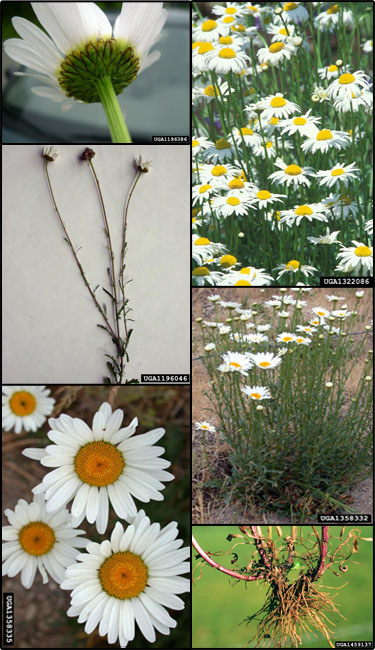Oxeye daisy (Leucanthemum vulgare)
 Synonyms: Chrysanthemum leucanthemum
Synonyms: Chrysanthemum leucanthemumDescription: Introduced to North America as an ornamental in the 1800s. Carries several crop diseases.
Habit: Erect; perennial; 8-24 in tall forb usually with unbranched stems.
Leaves: Alternate, lower leaves up to 5 in long, lobed or toothed, stalked; upper fewer, smaller and becoming stalkless.
Stems: Hairless; angled or furrowed; one plant can have up to 40 stems.
Flowers: 1-2 in across, mostly naked flower stalk on main stem, sometimes branching from leaf axils near the top, 15-35 white petals golden yellow button shaped disc in the center; up to 3/4 inch across.
Fruit and seeds: Seed pod, cylindrical, dry, 10 ribs and no fluffy pappus, can produce up to 200 seeds.
Habitat: Native to Europe. Found in disturbed sites, fields, pastures.
Reproduction: By seed.
Similar species: Shasta daisy (Leucanthemum xsuperbum); Stinking chamomile (Anthemis cotula); Corn chamomile (Anthemis arvensis).
Monitoring and rapid response: Hand-pulling for small infestations. Credits: The information provided in this factsheet was gathered from the Robert W. Freckmann Herbarium and the USDA PLANTS Database.
Individual species images that appear with a number in a black box are courtesy of the Bugwood.org network (http://www.invasive.org).Individual photo author credits may not be included due to the small display size of the images and subsequent difficulty of reading the provided text. All other images appear courtesy of Google (http://images.google.com).
Common Name: | Oxeye daisy |
Scientific Name: | Leucanthemum vulgare |
Family: | Asteraceae (Aster) |
Duration: | Perennial |
Habit: | Herbs |
USDA Symbol: | LEVU |
